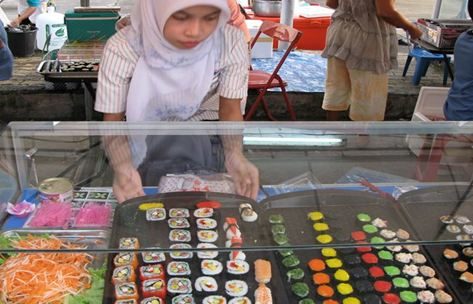There is a revolution going on in Southern Thailand and I’m not talking about the insurgency. Cities like the notorious Hat Yai, a sexual playground for Malaysian tourists are being transformed into vibrant Islamic business centres. This rapid transformation has been spurred on by the migration of Muslims from the three troubled provinces of Pettani, Yala, and Narathiwat to Songkhla Province, in order to get away from the trouble. One of the results of this is a growing cluster of young Thai Malay entrepreneurs who are finding innovative ways to develop new business models based upon Islamic principles.
This avant-garde young business group has seen the potential of integrating their beliefs into what they do businesswise. And this is paying off as the Thailand Muslim population is in excess of 6 million people, many cashed up from bumper rubber prices over the last few years. In addition the appeal of these products and services produced by these businesses are not just restricted to the Muslim population.
If one travels around the South of Thailand today there are Halal restaurants, boutiques, travel agents, tour companies, insurance, and consumer products all produced and operated by companies that aspire to comply with Islamic principles. Some larger projects like Halal hotels and condominiums for Muslim retirees from Malaysia and Singapore are being currently constructed. What one can feel talking to these entrepreneurs and seeing the results of their work is an aire of excitement, innovation and expectation that this strategy will lead to growth and success.
This is in stark contrast to south of the border in Malaysia where over the last 50 years an institutionalized mindset of dependence upon government contracts, favours, and grants has severely inhibited innovation. Symbolically, this can be seen through the individualized Islamic fashion worn by Southern Thai Muslim women verses the stereotyped fashion worn by Malaysian Malay women. Even the night markets in Southern Thailand are full of innovative Halal foods like dim sum and sushi with stalls decorated in colourful banners in contrast to the drab night markets across the border.
This “tale of two cities” along the border of Malaysia and Thailand probably reflects the vastly different approaches to development by the two countries. Thai development has been much more ad hoc than Malaysia, where ideas tend to be generated by individuals who do something about them using their own resources. If and when they are successful, others follow and build upon this base with complementary rather than competitive businesses. Soon after government agencies provide channels and assistance through their community industry and marketing programs. Later universities like Chulalongkorn set up fully accredited Halal testing labs to support the growing business cluster. These clusters start and grow almost naturally and this is occurring along the Islamic business front now.
In contrast, Malaysian development comes from top down planning. Much fanfare is given to new infrastructure projects with grand objectives. The participants attending launches and involved in implementation are bureaucrats and agency officials with very little participation by the private sector. Where opportunities are identified, an agency may set up a government linked company as a vehicle to exploit it, actually stifling out private enterprise growth rather than promoting it. The end result is an attempt to build a cluster with little private enterprise support, that doesn’t have any natural growth or momentum, continually requiring funds to prop it up.
This story tends to support what the creativity pundits say. Creativity and innovation comes from adversity and hardship rather than a comfortable and complacent environment. The Muslim entrepreneurs in Southern Thailand have had to make it on their own and not rely upon favors from a structure of cronies who can dish out contracts and funds. In addition this trend toward Islamic principled business shows that future wealth will come from innovation rather than connections, which is very important if substantiated and real economic development is going to occur. It’s not brick and mortar that will bring development, but new ideas and practices connecting hinterland, culture and entrepreneur to new market possibilities.
The Malay entrepreneurs of Southern Thailand as well aware that almost 25% of the world population are Muslims and that an Islamic approach to the market is sure to provide a regional source of competitive advantage in the international market arena within the not too distant future. Culture and religion can be a strong and powerful economic resource.
Their gung-ho attitude is to develop the market in Southern Thailand today and extend out to the region tomorrow. One can see through the Halal supply chain system developed by the Halal Research Centre at Chulalongkorn University that this is not just a dream. Some of the world’s major food manufacturers like Nestlé have already adopted it.
And finally what could this mean for the restless south of Thailand. Will growing economic prosperity and wealth be the best long term weapon against any insurgency? Can the people solve this themselves without any outside assistance? If this hypothesis is true, then the growing Islamic business cluster in Southern Thailand may marginalize the insurgency movement. However this doesn’t mean that the violence would end. When a movement is being marginalized it may seek attention thought further ‘high profile’ acts of violence. That’s the sad part of the story.
 Facebook
Facebook  Twitter
Twitter  Soundcloud
Soundcloud  Youtube
Youtube  Rss
Rss 
